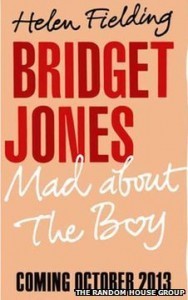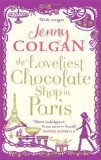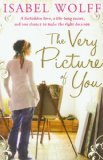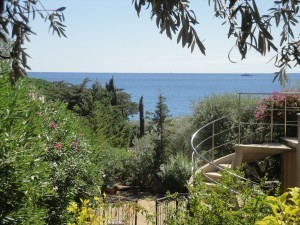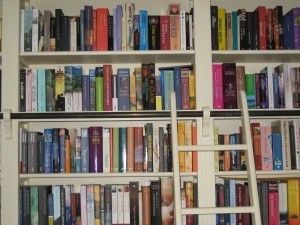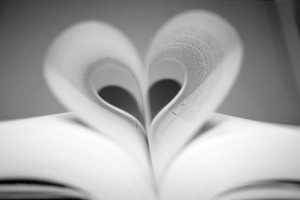Hannah Fielding's Blog, page 129
June 4, 2013
The return of Bridget Jones
The publishing world is atremble. Having recovered from the excitement of Dan Brown’s Inferno launch, eyes are now firmly on the release of The Next Big Sensation, which, it is hoped by publisher Jonathan Cape, will be Helen Fielding’s new novel Mad About the Boy, out in October of this year (presumably, the title is based on Noel Coward’s beautiful song, made famous by jazz vocalist Dinah Washington).
There’s no doubting that Bridget Jones’s Diary changed the face of women’s literature – some will argue, it is the ultimate ‘chick lit’ book, and certainly for many women it embodied the struggles they were encountering at that time in their lives.
It has been a long hiatus (nine years) since the last book, The Edge of Reason. Helen Fielding said of the gap in an interview for Radio 4’s Women’s Hour: ‘I sort of lost my voice with Bridget for a long time after the unexpected success when it first came out. It was very easy to write and to be honest, then I got all self-conscious.’
But at last, an idea eventually struck. The new book is in diary format again, and the publishers have shared the following extract:
Wednesday 24 October 2012
11.27 p.m. Just presss d SEND. Iss fineisn’t it?
You see, this is the trouble with the modern world. If it was the days of letter-writing, I would never even have started to find his address, a pen, a piece of paper, an envelope, a stamp, and gone outside at 11.30p.m. to find a postbox. A text is gone at the brush of a fingertip, like a nuclear bomb or exocet missile.
DATING RULE NO:1
DO NOT TEXT WHEN DRUNK
I wonder just how much the digital revolution will feature in the new book. Twitter. Facebook. Texting. How these means of communication have transformed the modern romance!
What would you like to see in the new Bridget Jones novel? Here’s my wish list:
A more self-confident Bridget with less body image concerns
Plenty more funny mishaps
A frank and meaningful exploration of what it is to be a woman in love today
A fulfilling career for Bridget
Mark Darcy and Daniel Cleaver (of course!)
A new Bridget Jones film entitled Bridget Jones’s Baby is in development, according to media reports, but not at a point where filming can begin. There is media speculation over who will play Bridget in that film and if one is made of the forthcoming book, but I don’t think I am alone in thinking surely only Renee, Colin and Hugh can top the bill. Especially Colin…
I for one am very much looking forward to the release of the book, and I’ll be sure to review it on the website.
June 2, 2013
The colour of love
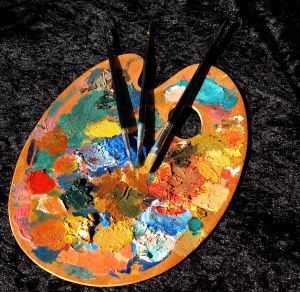 One of the elements of my writing that readers most often comment on is the description. I was brought up to be a highly descriptive writer, because I spent so many years immersed in French literature, because writing in English (not my native tongue) demands that I consider carefully vocabulary, and because my favourite poets and writers have always been those who paint vivid pictures of scenes in the reader’s mind. But most of all, I think, because I am drawn to beautiful settings, and when I write about them, I so want to transport the reader to a time and place and allow them to experience what is in my mind.
One of the elements of my writing that readers most often comment on is the description. I was brought up to be a highly descriptive writer, because I spent so many years immersed in French literature, because writing in English (not my native tongue) demands that I consider carefully vocabulary, and because my favourite poets and writers have always been those who paint vivid pictures of scenes in the reader’s mind. But most of all, I think, because I am drawn to beautiful settings, and when I write about them, I so want to transport the reader to a time and place and allow them to experience what is in my mind.
Colour is a key component of description, as any writer will agree. We don’t simply write that the heroine wore a sundress; we write that she wore a sundress the colour of cornflowers that offset the russet highlights in her hair and brought out the fire in her emerald eyes. In my own life, I love to incorporate rich, bright colours where I can – in clothes, in room décor, in garden planting, even in hors d’oeuvres served to guests. Colour is passion and light and life incarnate. It brings joy and warmth. It inspires.
My novel Burning Embers is set in Kenya, and to my mind Africa is synonymous with wonderful, beautiful colours, and so I was careful to weave colour into descriptions wherever possible. For example, here’s a description of Coral’s early reaction to Kenya:
Even with her mind awash with childhood memories, Coral found it difficult for her eyes, accustomed to the more sedate English countryside, to take in all at once the opulence of color, the sense of space, and the profusion of brilliant life. The burning sky seemed too blue, the rich soil too red, and the irrepressible vegetation too green.
When I write, I always have to hand a thesaurus, and I strive to find the perfect word for each description. That often means looking beyond the mundane to words whose meaning and look and sound create the mood I am seeking to convey. For example:
Orchids sprouted from emerald-green grass between banks of compact, glossy thorn bushes and flame-colored reeds. Along the road, acacias, tamarind, frangipani, and purple jacarandas thrust their flowering branches into the never-ending, azure sky.
Of course, because Burning Embers is a fiery, passionate love story set in a hot and sultry country, the colours red and pink feature prominently (take the name of the heroine, Coral, for instance), but these are offset by the green of the verdant vegetation all around and the cooling, calming blues of the sea and the sky.
I have always believed a strong link exists between all art forms, and that the best writing is a kind of painting of words. Painting is a theme in the book – Rafe is a talented artist – and as I wrote I found myself considering often the connection between the colourful setting and the artist’s brushstroke:
With amazement and wonder, she watched multicolored sea creatures nibble at the reefs, schools of brightly striped angelfish and others wildly spotted or recklessly patterned, swimming among vivid anemones and striking coral bouquets as if straight out of an artist’s canvas.
The red of the loose, sandy soil and the green of the long, spiky leaves set under the azure-blue sky were like a vibrant painting.
Were I to commission an artist to create a painting to encapsulate Burning Embers (now there’s a thought!) I would be expecting above all else bold, stirring colour. Because colour is such a key part of the romantic atmosphere.
To close, I leave you with a beautiful song by Celine Dion called ‘The Color of My Love’, which beautifully conveys that special relationship between love and art and colour.
May 31, 2013
Book review: The Loveliest Chocolate Shop in Paris by Jenny Colgan
From the blurb:
As dawn breaks over the Pont Neuf, and the cobbled alleyways of Paris come to life, Anna Trent is already awake and at work; mixing and stirring the finest, smoothest, richest chocolate; made entirely by hand, it is sold to the grandes dames of Paris.
It’s a huge shift from the chocolate factory she worked in at home in the north of England. But when an accident changed everything, Anna was thrown back in touch with her French teacher, Claire, who offered her the chance of a lifetime – to work in Paris with her former sweetheart, Thierry, a master chocolatier.
With old wounds about to be uncovered and healed, Anna is set to discover more about real chocolate – and herself – than she ever dreamed.
No prizes for guessing why I picked up this novel! Romance + chocolate + Parisian backdrop sounds like a recipe for a good love story to me.
I very much like the book’s setting, and think the author encapsulates the Parisian well – though I’d have loved more description of this most romantic of settings, and perhaps a little more exploration of French characters beyond the stereotypical brusque ones.
The chocolatier element of the plot is delightful – really evocative and fascinating, and I confess I found myself craving a sliver of fine chocolate several times during the reading! I love the inclusion of recipes at the back, and will be sure to try out one or two.
One of my favourite elements of the book is the way the author blends together two stories – those of modern-day Anna and of Claire when she was young. I especially engaged with Claire’s love story; she’s a very likeable character, even if she frustrates us a little for having waiting so long to fight for love.
I love the character of Anna’s roommate – exhibitionist, eccentric, very ‘Moulin Rouge’; just what a sad and lonely girl who’s new to Paris needs to thrust her into the thick of life.
This is a romance novel, but different in the sense that it deals with some serious issues, and the undercurrent of the book is far from light and fluffy, but really quite dark and thought-provoking. Not a book to pick up for romantic light relief, but one to read if you like grande tragédie and love grounded firmly in reality. And Paris!
The Loveliest Chocolate Shop in Paris is available now from Amazon; click on the book cover below to visit the store.
May 29, 2013
Summer in France
May 28, 2013
Literary Death Match: Hats off to courageous authors
Being a published writer today means being within a competitive market – trying to stand out in a crowd with your words. But one organisation has taken this notion of competitively to new heights.
Yesterday I was fascinated to watch on BBC News an item about a new phenomena in the world of writing and publishing called the Literary Death Match.
The website for the movement explains what Literary Death Match is all about:
Each episode of this competitive, humor-centric reading series features a thrilling mix of four famous and emerging authors (all representing a literary publication, press or concern — online, in print or live) who perform their most electric writing in seven minutes or less before a lively audience and a panel of three all-star judges. After each pair of readings, the judges — focused on literary merit, performance and intangibles — take turns spouting hilarious, off-the-wall commentary about each story, then select their favorite to advance to the finals.
The two finalists then compete in the Literary Death Match finale, which trades in the show’s literary sensibility for an absurd and comical climax to determine who takes home the Literary Death Match crown.
Writing is still, silent, waiting patiently on the page to be digested. But this movement is taking writing into a new arena, bringing it to life audibly in front of an audience in a lively, humorous way. It’s melding the art forms of literature and performance (with a spot of the TV talent show format mixed in).
I’m excited to see any new development that celebrates books, that widens readership and that is passionate about innovation and creativity within the arts. In addition, I love the idea of writing becoming something aural, tying in with the traditional roots of literature in fireside storytelling. One of the authors interviewed by the BBC highlighted that she loved to read her work aloud – that in fact something is lost when it’s simply words on paper. I agree. When I write, I choose words not only for their meaning and their visual appeal on paper, but for their sound – there is a rhythm, a musicality to writing, I think.
Writing is, by nature, a solitary pursuit, and the Literary Death Match is a wonderful opportunity to step away from the drafty garret and really engage with readers. But my goodness, one has to be brave to do so! It’s fast-paced, furious, witty – truly a death match. Not for the faint-hearted, but I think those who attend an event must come away very impressed with the intelligence and strength of the contending authors.
Literary Death Match is touring the world, so look out for a date near you soon. For more information, visit http://www.literarydeathmatch.com. You may also enjoy watching some videos of past events: http://www.literarydeathmatch.com/audio-and-video/.
May 26, 2013
The thrill of the storm
My home in the south of France, where I’m residing for the summer, has panoramic views over the Mediterranean. On a calm day, I sit out and watch the sparkling sea melding into the hazy cobalt horizon, and I get lost in the majesty of sweeping sunsets and sunrises whose colours never fail to take my breath away. But as for any coastal location, the calm cannot be permanent, and before long a storm comes to clear the air and drench the vegetation and send us all scuttling into our homes to watch, wide-eyed, as the spectacle unfolds; Mother Nature’s way of reminding us of her might and her theatrical side.
In France, I’ve come to know the signs that a storm is brewing: there’s threat implicit in the air, a difference in the wind, and an accumulation of fast-moving clouds – such beautiful clouds. Here are photographs I took before a storm in Ste Maxime this week.
[Show as slideshow]




Who could failed to be moved by such a sight! The colours, the shapes, the textures – it’s like the sky is God’s canvas and he’s turned to wonderfully expressive oil painting with bold, brash strokes calling on every colour combination in his palette.
As a romantic – and an author – I love a good storm. They contain so much emotion and drama: the perfect backdrop for an unfolding love story. Storms are thrilling, but that thrill contains fissions of fear. How may those duel reactions – excitement and terror – affect lovers?
When I was writing Burning Embers, I wanted to explore how the emotions aroused by a storm would feed into a developing relationship between two people. So I placed poor Coral, who’s terribly afraid of thunder, in a deserted and remote valley with Rafe, who’s far too strong and manly to tremble in the face of lightning flashes, and I brewed up a sudden and violent storm. Here’s the result:
A flash of long blue lightning split the sky, closely followed by a crash of thunder. Coral instinctively threw herself into Rafe’s arms, hiding her face against his broad chest. She had always had a strong phobia of thunderstorms. Now she knew why the place had seemed eerie, why there had been no bird song or insect tick-tocks, no scuffling and ruffling in the undergrowth. Even though the skies when they entered the valley had not foretold the electrical storm that was to come, just like with the animals, her instinct had told her that something was wrong. But she had been too distracted by the turbulence crackling between her and Rafe to pay attention to the changing sky.
Rafe, too, was shaken out of his daze and turned his head to see that the sun had dropped behind the mountain. Dense clouds had swept into the valley and were hanging overhead like a black mantle.
“Where did that come from? No storm was forecast for today?” he muttered, jumping up.
There was another tremendous peal of thunder, lightning lit up the whole glade, and again another crash. Then the heavy drops of rain came hammering down against the treetops, pouring down through the foliage.
A wind was starting up. Without hesitation, Rafe folded the blanket into a small bundle and tucked it under his arm. He slung the hamper over his shoulder, and lifting Coral into his arms, he climbed his way up to the next level of the escarpment where a ledge of rock was jutting out and found the entrance to a cave where they could shelter. Coral was shivering. She tucked her face into his shoulder, her fingers tightly gripping his shirt. She was completely inert, paralyzed by fear. They were both drenched.
There was no way they would be able to get back to Narok tonight. Coral knew from her childhood that storms were always long in this part of the country, and through her panic she prayed that he wouldn’t be piloting that little plane back in this howling gale. At least here they were protected from the storm. It was not yet completely dark. Rafe looked around, still holding her tightly against him. Coral couldn’t herself as she sobbed uncontrollably.
“Shush, it’s all right,” he whispered softly in her ear. “It’s only a storm. By tomorrow morning it’ll all be over.” He brushed her tears away as more fell. “I’m going to have to set you down for a moment, Coral. I need to light us a fire and get you out of those wet clothes.”
What do you think? Do you find storms simply terrifying, or do you enjoy the show? Do you sit through them calm and unaffected, or feel exhilarated and stirred? Can you imagine a storm inciting romance with a partner? Can a storm create a sort of bubble, where barriers crumble and people come together? If so, what happens after the storm – does the connection last, or does the intensity wash away? I would love to hear your thoughts.
May 24, 2013
Book review: The Very Picture of You by Isabel Wolff
From the blurb:
A forbidden love, a life-long secret, and one chance to make the right decision.
Ella has always been an artist, jotting down pictures from a young age, and now in her thirties she has made it her profession. Commissioned to capture memories, fading beauty and family moments, her sitters often reveal more about themselves than merely their outward appearance.
When Ella’s younger sister Chloe asks her to paint a portrait of her new fiancé Nate, Ella is reluctant. He is a brash American who Ella thinks has proposed far too fast, so the thought of spending many hours alone with him fills her with dread. But before long Ella realises there is more to Nate than meets the eye.
Beautifully inter-weaving the stories of Ella’s sitters – from the old lady with a wartime secret, to the handsome politician who has a confession to make – with Ella’s own hunt for her real father and slow realization that she is falling in love with the wrong man, Isabel Wolff delivers a mesmerizing story that delivers a powerful emotional punch.
A truly unforgettable portrait of the many aspects of love.
I bought this book because I was attracted to the blurb – in my own book, Burning Embers, the hero, Rafe, paints portraits of the heroine, Coral, and I loved exploring in my own writing how art can express and heighten emotional connections.
The Very Picture of You is a thought-provoking collage of interconnecting romantic stories centred on portrait painter Ella, set in contemporary London. Brought up to believe that she and her mother had been abandoned by her father at a young age, Ella is scarred and unable to overcome her distrust of men. Told entirely from Ella’s point of view, the story documents the loves and lives of a range of characters whose only apparent link is that they have commissioned her to paint for them. Despite this, each story has an impact upon Ella, challenging her viewpoints and causing her to look critically at her own life story and future.
… a competent portrait just catches a likeness and a good portrait reveals aspects of the sitter’s character. But a great portrait will show something about the sitter that they didn’t even know themselves.
Ella is forced to confront the truth behind long-standing family secrets — her parent’s long-past relationship was much more complicated than she has been led to believe, with implications for Ella’s future. In addition, Ella finds herself torn when she falls for Nate, the fiancé of her half-sister, after she is asked to paint him.
I felt a burst of anger with Chlo ë : in asking me to paint Nate she had, albeit unwittingly, put before me a feast that I could never touch. I felt like Tantalus, neck-deep in water that he could never drink, grasping at fruit that was always just out of reach.
As her sister and Nate’s wedding day looms events crescendo with an unexpected twist.
Isabel Wolff has an excellent writing style; the book flows seamlessly between stories and the reader is never abandoned as sub-plots twist and weave. The contrasting character back stories keep the reader engaged and the overlap ensures that this book is difficult to put down. Isabel’s use of emotion within descriptive passages gives real insight into how it feels to be Ella as she struggles with her emotions and attitudes towards both Nate and her family. The reader develops a genuine liking for the character and a real desire for her future happiness.
Overall, this is a truly enjoyable and fulfilling book, and I hope that Isabel Wolff will revisit Ella’s character in the future.
The Very Picture of You is available now from Amazon; click on the book cover below to visit the store.
May 23, 2013
Delighted to be back in France
May 21, 2013
How book recommendations enrich the reading experience
Picture the scene:
You’re having coffee with a dear friend, and the subject turns to books you’ve read recently. You tell her about a romance novel you really enjoyed. She tells you about a work of literary fiction she found moving and inspiring.
‘That sounds wonderful,’ you say.
‘It is,’ she replies. ‘Look, I have my copy in my bag. I’ll lend it to you.’
‘Thank you!’ you say. ‘And here, have my copy of this passionate, evocative, moving love story. It will make your heart melt.’
‘Thank you!’ she says. ‘I can’t wait to read it.’
Just writing this scenario that brings a smile to my face. It’s a beautiful example of friendship, of like minds connecting, of generosity and of sisterhood. It’s celebratory of books – those wonderful bindings of paper that bring joy and light and learning. And it’s the beginning of what will certainly be an enriching experience for both friends.
For me, book recommendations are to be treasured. Quite simply, a book can mean much more when a friend has recommended it you, saying, ‘Read this – I think you’ll like it.’ The book becomes a gift, and with each word you not only take in the meaning, but you also search for extra meaning, for why your friend thought this book was worth your reading.
Some of my favourite books have been discovered via recommendations, and I have also read books I probably would never have chosen for myself, which has widened my horizons. In addition, I have got much out of recommending books to others, especially when they, too, have fallen in love with a novel.
For me, the very best recommendations are accompanied with a physical copy of the book. The handing over of a novel that you love is by no means easy (and only possible if you trust the friend to care for it and return it; or are prepared to buy another copy tout de suite), but it really does deepen the meaning of the gesture. The book is a gift – a hope for enjoyment embodied in a beautiful object. And if the book is old and well-thumbed, so much the better, for your friend will be humbled by your sharing such a loved object.
But of course we are living in a digital revolution, and so recommendations without physical books are increasingly more commonplace. I love the website Goodreads for sharing recommendations and getting tips for new books from those of others. Each week I post a review of a book I’ve enjoyed there (and on my website) for other readers to benefit from, and I browse the books that others are reading and recommending. It’s a rich source indeed for discovering wonderful new writers.
If you’re anything like me, you feel sad and deflated and a little lost when you finish a book, and light and happy and excited when you’re about to start a new one that you really like the look of. Book recommendations are the perfect solution to keeping hold of the latter feeling to minimise the impact of the former.
So recommend away, I say. Talk about books you like. Ask what others are reading. Lend out your books. Let them go if need be and buy new ones. Share the book love!
May 19, 2013
The dwindling of emotion in British novels
I was fascinated to read of research published in scientific journal PLOS ONE that has found that British writers today are less emotive in their writing than their counterparts of 100 years ago. Researchers examined five million books published between 1900 to 2000 to see how often emotive words – those that express love, fear, joy, sadness, surprise, anger and disgust – appeared. The study concluded that:
Those writing at the turn of the 20th century used 14% more emotive words than those writing at the turn of the 21st century.
Twice in the 100-year history the joy emotion peaked: after the First World War and in the 1960s.
Contrastingly, following the Second World War there was a clear increase in words conveying sadness.
Since 1960, fear-related words have steadily increased.
American English has become more emotional than British English in the last 50 years.
As I read the reports of the research, I found myself thinking that this pulling back from emotion must relate to the heady rise in popularity of the romance novel. Think, for example, of the steady growth of the British romance imprint Mills & Boon since its launch in 1908. For even if every other genre of book has become a little less emotional, I can’t imagine that applies to the romance genre. And so readers hungry for real emotion – passion, love, anguish, joy – turn to romance novels, where authors are free to express all and take the reader on a emotional journey.
Happily, for the romance reader, I think there is little difference between British and American romance novels in terms of emotion. Because when we pick up a romance book – whatever the nationality or place of publication – we want pure escapism. And to me, escapism must include a call to the emotions. Books provide comfort and release, and a means to learn, grown and process our own feelings. After a long, hard day, you may be tired of your own thoughts and feelings, but when you pick up a novel and slip into another world, the passion and joy and excitement – and yes, even the fear and anger – that you find there are cathartic.
Emotive books matter. If all you read is unemotive books then the entire point of reading is lost. As British writer William Nicholson wrote, ‘We read to know that we are not alone.’ So when we’re curled up in a chair lost in a romance novel, we’re really not lost at all. When we’re ‘indulging in pure escapism’, we’re not really escaping at all. In the world of the romance novel, the reader is no floundering ship alone in the ocean – she’s connected to the world, part of the world, tapped in to all the emotion running through humanity. The romance reader is one of those courageous enough to feel, and that’s something to be admired indeed.

